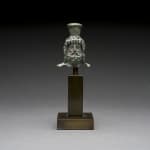Roman Bronze Head of Sarapis, 100 CE - 300 CE
Bronze
height 5.4 cm
height 2 1/8 in
height 2 1/8 in
FZ.410a
Further images
This consummately crafted, hollow cast bronze sculpture is possessed of an inherent monumentality which belies its jewel-like, diminutive size. His long, flowing hair frames his face and covers his ears....
This consummately crafted, hollow cast bronze sculpture is possessed of an inherent monumentality which belies its jewel-like, diminutive size. His long, flowing hair frames his face and covers his ears. A fringe of five prominent curls laps his forehead. His crescent-shaped moustache is full and falls down alongside his mouth which it conceals. His beard is full and bifurcated. He wears a kalathos, or basket in which grained was measured out, on his head as an attribute. The kalathos serves to identify this image as Sarapis, a syncretistic deity introduced into the Greek pantheon by the early Ptolemies, who were the successors of Alexander the Great as rulers of Egypt.
The god is shown in the guise of the great Greek elder gods such as Zeus, Poseidon, and Hades whose images are characterized by full beards, flowing moustaches, and long, curly hair. His kalathos associates him with the Egyptian god, Osiris, whose associations with the grains grown in Egypt complemented his role as the lord of the hereafter. The cult of Sarapis, therefore, combined into one the religious beliefs of the ancient Greeks together with those of the native Egyptians.
Tradition credits Byraxis, a Greek sculptor active in the court of Ptolemy II Philadelphus, with the creation of the cult statue of Sarapis which stood in the vast Serapeum complex in Alexandria. The monumental blocks of worked rose-colored Syenite-granite still lying about that site attest to the size and grandeur of the temple of Sarapis in Alexandria within which the famed cult statue created by Bryaxis stood. The style of the hair, beard, and moustache of this jewel-like bronze image are so close to other more monumental depictions of Sarapis in both Egyptian stones and marble that all reflect the appearance of his cult statue by Bryaxis. All of these evocations were created during the course of the second century AD when the cult of Sarapis enjoyed wide-spread popularity throughout the Roman Empire. That popularity was due in part to such Roman emperors as Hadrian whose favorite, Antinoos, was deified after having been drowned in the Nile. It is rare, indeed, to come across such an exacting evocation of an ancient cult statue created in such an aesthetically accomplished manner.
References:
John E. Stambaugh, Serapis under the Early Ptolemies (Leiden 1972), still remains a standard reference work on the subject; and compare D. Wildung and G. Grimm (editors), Götter und Pharaonen (Hildesheim 1979), nos. 154 and 155, for comparable images in granite and marble, respectively.
The god is shown in the guise of the great Greek elder gods such as Zeus, Poseidon, and Hades whose images are characterized by full beards, flowing moustaches, and long, curly hair. His kalathos associates him with the Egyptian god, Osiris, whose associations with the grains grown in Egypt complemented his role as the lord of the hereafter. The cult of Sarapis, therefore, combined into one the religious beliefs of the ancient Greeks together with those of the native Egyptians.
Tradition credits Byraxis, a Greek sculptor active in the court of Ptolemy II Philadelphus, with the creation of the cult statue of Sarapis which stood in the vast Serapeum complex in Alexandria. The monumental blocks of worked rose-colored Syenite-granite still lying about that site attest to the size and grandeur of the temple of Sarapis in Alexandria within which the famed cult statue created by Bryaxis stood. The style of the hair, beard, and moustache of this jewel-like bronze image are so close to other more monumental depictions of Sarapis in both Egyptian stones and marble that all reflect the appearance of his cult statue by Bryaxis. All of these evocations were created during the course of the second century AD when the cult of Sarapis enjoyed wide-spread popularity throughout the Roman Empire. That popularity was due in part to such Roman emperors as Hadrian whose favorite, Antinoos, was deified after having been drowned in the Nile. It is rare, indeed, to come across such an exacting evocation of an ancient cult statue created in such an aesthetically accomplished manner.
References:
John E. Stambaugh, Serapis under the Early Ptolemies (Leiden 1972), still remains a standard reference work on the subject; and compare D. Wildung and G. Grimm (editors), Götter und Pharaonen (Hildesheim 1979), nos. 154 and 155, for comparable images in granite and marble, respectively.





